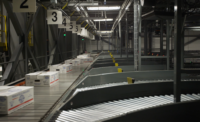With the holiday season and its related eating occasions fast approaching, meat processors are gearing up for one of the busiest times of the year. Thanksgiving is a crucial time for the industry, and the surge in demand places significant pressure on packaging operations.
Charles Haverfield, CEO of US Packaging & Wrapping, shares strategies for how meat processors can scale up and meet holiday demand with packaging solutions.
What are some strategies for meat processors to successfully scale up packaging operations to meet holiday season demand?
To successfully scale up packaging operations, I’d say the most important strategy for processors is to focus on automation to optimize both speed and consistency. The US is currently going through a tough labor shortage, with the workforce still down by 1.7 million people compared to pre-2020 levels. Meat processors have been hit hard from the aftermath of the pandemic, and these labor shortages continue to be felt four years on. Automated packaging solutions are not only essential to addressing these labor shortfalls but also maintain operational efficiency under pressure. Automation enhances the ability to package products consistently and at scale, which is crucial during the high-demand Thanksgiving period.
What benefits to overall operational efficiency does packaging line automation offer?
First and foremost, automating packaging lines increases speed and throughput, which is essential during high-demand periods like Thanksgiving. Automated systems can handle large volumes of product consistently, reducing bottlenecks in production. Automation also enhances consistency in product packaging, ensuring that each package is sealed properly and labeled accurately, reducing the risk of product recalls or contamination. Moreover, automated systems can be adjusted quickly to accommodate different product sizes and formats, offering flexibility to meet varied consumer preferences. In the long term, automation leads to reduced labor costs, higher productivity and improved quality control, making it an essential strategy for meat processors looking to scale operations and remain competitive.
What are some key considerations for meat and poultry processors for automating a primary packaging line vs. a secondary packaging line?
Primary packaging must prioritize food safety and hygiene above all else. That’s why the materials we use, such as vacuum-sealed or modified atmosphere packaging (MAP), ensure extended shelf life while maintaining the integrity of the product. Automation in primary packaging is particularly effective in reducing contamination risks and increasing efficiency, as it minimizes human contact and ensures consistency in sealing, portioning and labeling. In contrast, secondary packaging is about preparing the product for transportation and distribution. Key considerations here include efficiency in bundling, boxing, labeling, and palletizing. Automation in secondary packaging prioritizes speed and accuracy, ensuring products are grouped and prepared for shipment with minimal errors. The focus shifts from product safety to logistical efficiency and the ability to scale operations. Processors need to assess how scalable and flexible their automation systems are, particularly during peak seasons like Thanksgiving, when handling large volumes and various product sizes becomes critical for both stages.
What unique packaging requirements do meat products sold via e-commerce pose?
In traditional retail, where consumers will visit brick-and-mortar stores, products are stored in temperature-controlled environments until purchase. However, e-commerce meat packaging must ensure that products remain fresh and safe throughout the entire delivery process, which often involves extended shipping times. This means packaging must be designed to maintain the cold chain, typically involving the use of insulated containers, gel packs or dry ice to preserve the product during transit. Additionally, packaging for e-commerce must be more durable to withstand potential handling abuse during shipping while still being lightweight to control costs. This likely means more second packaging is needed to ensure the meat products do not degrade during transport.
How does meat and poultry packaging intersect with sustainability goals while ensuring food safety and shelf life?
There’s no denying the intersection of sustainability and food safety is a complex challenge for meat and poultry processors. On one hand, consumers and retailers are increasingly pushing for environmentally friendly packaging options, such as 100% recyclable or compostable materials. And it pays green to go green according to Tyson Foods, which found today’s consumer is willing to pay 20% more for sustainable fresh meat. On the other hand, packaging must maintain stringent food safety standards and extend shelf life, particularly for perishable products like meat. Plastic has long dominated in this area thanks to its durability, flexibility and ability to provide airtight seals that prevent contamination and spoilage. Innovations like Post Consumer Regrind (PCR) film are gaining traction as a possible alternative, allowing processors to reduce their reliance on virgin plastics. However, the challenge remains in ensuring that these sustainable materials can meet the same food safety and performance standards as traditional options. There’s no clear solution to the sustainability problem yet, and until legislation at a federal level is made and consistent standards are established, meat processors must navigate a complex landscape of balancing sustainability goals with regulatory compliance and operational efficiency.

.png?height=96&t=1647275041&width=96)





